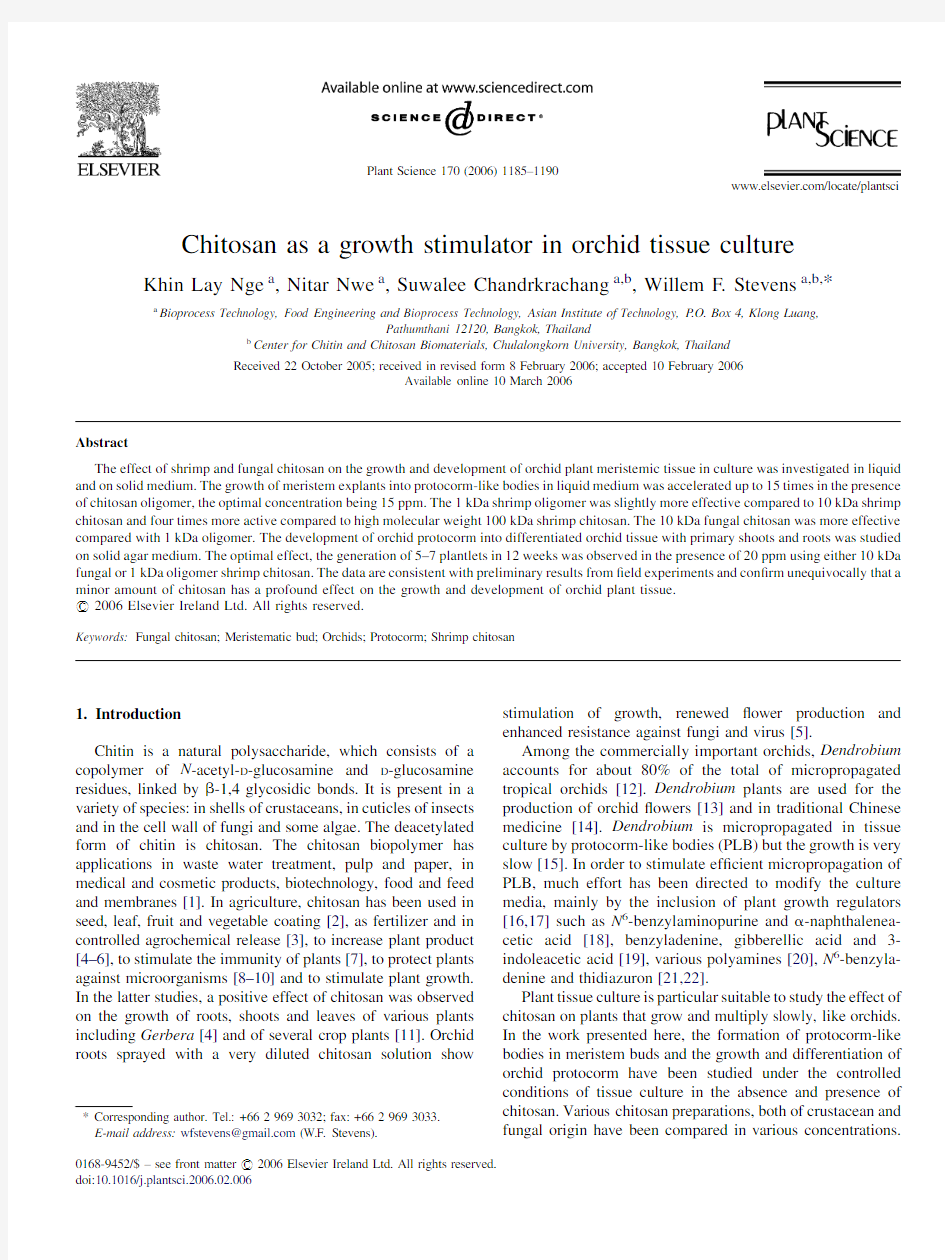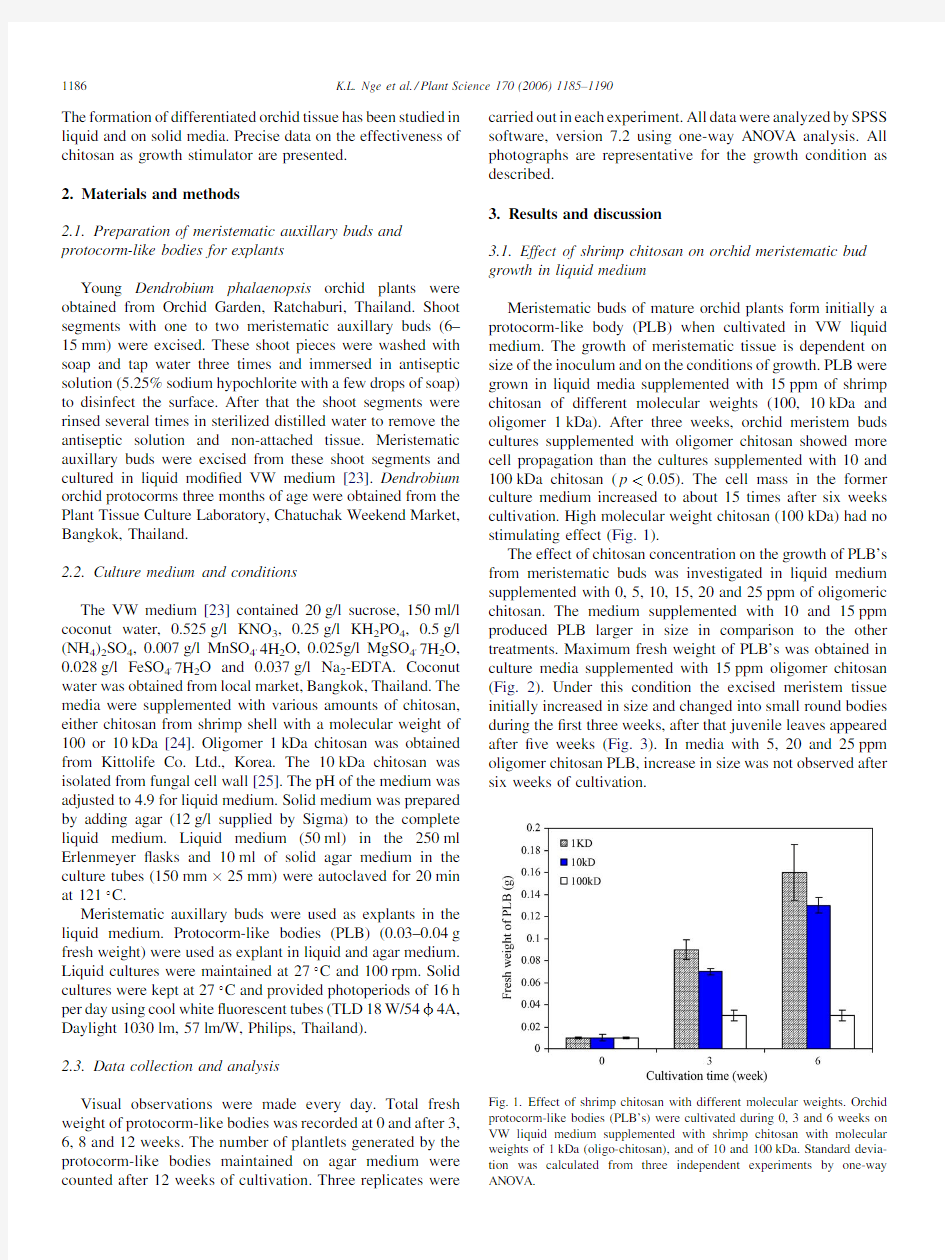Ts-2 chitosan as a growth stimulator in orchid tissue culture


Chitosan as a growth stimulator in orchid tissue culture Khin Lay Nge a,Nitar Nwe a,Suwalee Chandrkrachang a,b,Willem F.Stevens a,b,*
a Bioprocess Technology,Food Engineering and Bioprocess Technology,Asian Institute of Technology,P.O.Box4,Klong Luang,
Pathumthani12120,Bangkok,Thailand
b Center for Chitin and Chitosan Biomaterials,Chulalongkorn University,Bangkok,Thailand
Received22October2005;received in revised form8February2006;accepted10February2006
Available online10March2006
Abstract
The effect of shrimp and fungal chitosan on the growth and development of orchid plant meristemic tissue in culture was investigated in liquid and on solid medium.The growth of meristem explants into protocorm-like bodies in liquid medium was accelerated up to15times in the presence of chitosan oligomer,the optimal concentration being15ppm.The1kDa shrimp oligomer was slightly more effective compared to10kDa shrimp chitosan and four times more active compared to high molecular weight100kDa shrimp chitosan.The10kDa fungal chitosan was more effective compared with1kDa oligomer.The development of orchid protocorm into differentiated orchid tissue with primary shoots and roots was studied on solid agar medium.The optimal effect,the generation of5–7plantlets in12weeks was observed in the presence of20ppm using either10kDa fungal or1kDa oligomer shrimp chitosan.The data are consistent with preliminary results from?eld experiments and con?rm unequivocally that a minor amount of chitosan has a profound effect on the growth and development of orchid plant tissue.
#2006Elsevier Ireland Ltd.All rights reserved.
Keywords:Fungal chitosan;Meristematic bud;Orchids;Protocorm;Shrimp chitosan
1.Introduction
Chitin is a natural polysaccharide,which consists of a copolymer of N-acetyl-D-glucosamine and D-glucosamine residues,linked by b-1,4glycosidic bonds.It is present in a variety of species:in shells of crustaceans,in cuticles of insects and in the cell wall of fungi and some algae.The deacetylated form of chitin is chitosan.The chitosan biopolymer has applications in waste water treatment,pulp and paper,in medical and cosmetic products,biotechnology,food and feed and membranes[1].In agriculture,chitosan has been used in seed,leaf,fruit and vegetable coating[2],as fertilizer and in controlled agrochemical release[3],to increase plant product [4–6],to stimulate the immunity of plants[7],to protect plants against microorganisms[8–10]and to stimulate plant growth. In the latter studies,a positive effect of chitosan was observed on the growth of roots,shoots and leaves of various plants including Gerbera[4]and of several crop plants[11].Orchid roots sprayed with a very diluted chitosan solution show stimulation of growth,renewed?ower production and enhanced resistance against fungi and virus[5].
Among the commercially important orchids,Dendrobium accounts for about80%of the total of micropropagated tropical orchids[12].Dendrobium plants are used for the production of orchid?owers[13]and in traditional Chinese medicine[14].Dendrobium is micropropagated in tissue culture by protocorm-like bodies(PLB)but the growth is very slow[15].In order to stimulate ef?cient micropropagation of PLB,much effort has been directed to modify the culture media,mainly by the inclusion of plant growth regulators [16,17]such as N6-benzylaminopurine and a-naphthalenea-cetic acid[18],benzyladenine,gibberellic acid and3-indoleacetic acid[19],various polyamines[20],N6-benzyla-denine and thidiazuron[21,22].
Plant tissue culture is particular suitable to study the effect of chitosan on plants that grow and multiply slowly,like orchids. In the work presented here,the formation of protocorm-like bodies in meristem buds and the growth and differentiation of orchid protocorm have been studied under the controlled conditions of tissue culture in the absence and presence of chitosan.Various chitosan preparations,both of crustacean and fungal origin have been compared in various concentrations.
https://www.wendangku.net/doc/6617909722.html,/locate/plantsci
Plant Science170(2006)1185–1190
*Corresponding author.Tel.:+6629693032;fax:+6629693033.
E-mail address:wfstevens@https://www.wendangku.net/doc/6617909722.html,(W.F.Stevens).
0168-9452/$–see front matter#2006Elsevier Ireland Ltd.All rights reserved.
doi:10.1016/j.plantsci.2006.02.006
